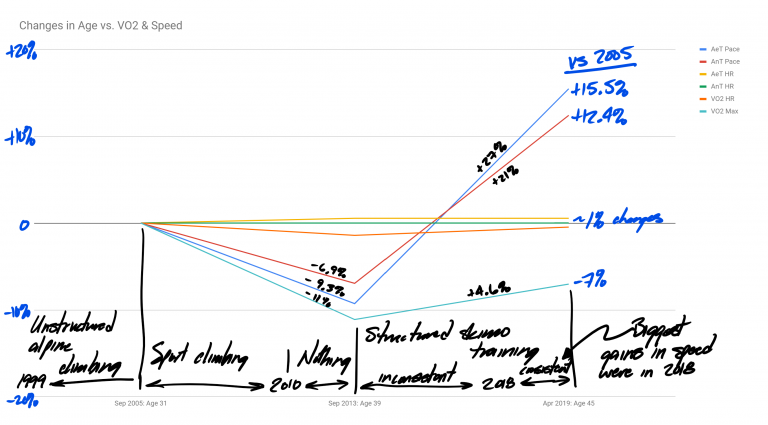Max VO2 is the Holy Grail of endurance qualities, right? Looking at its importance in the fitness landscape, you’d sure think so. Many training methodologies embrace it as the metric that rules all others, and the popular media fuels this misunderstanding with articles about how to boost your max VO2 in order to be the best athletic you. But of the three main components that pertain to endurance—economy, speed at Lactate Threshold (aka Anaerobic Threshold), and max VO2—max VO2 correlates the least with performance. It’s time to debunk the max VO2 myth.
My Growing Skepticism
During my ski racing career, in which I was a World Cup also-ran, I was tested several times for max VO2. I always tested with a higher max VO2 than the other US Ski Team guys I raced against who routinely placed in the top 10 and occasionally even in the top 5 in World Cup races—much better than I ever did. That’s when I began to question the validity of the assumption that max VO2 is a predictor of performance. I sensed that something else was holding me back. Years later, I pinpointed that weakness: economy, especially at racing speeds. Economy is a metric that didn’t even figure into training 35 years ago.
Later on, my long-burning questions about max VO2 turned into full-blown skepticism of the models that place this quality on a pedestal above all others—and often to the detriment of those other qualities.
Shifting an Athlete's Training: A Real-World Example
I have personally trained athletes with low max VO2 values who have been quite successful at the World Cup level. I have also trained athletes with max VO2 numbers in the stratosphere who were not competitive at the World Cup level.
Before I worked with him, one of those skiers with a low max VO2 had been the recipient of huge financial and material resources from the US Ski Team over the course of five years—years that were devoted almost exclusively to improving his max VO2 at the expense of other aspects of his training. He did max VO2–protocol interval sessions three times a week, and his max VO2 was tested three or four times a year. The net effect of this myopic approach was essentially zilch. There was no change in his vaunted max VO2 value, and his race performance stagnated. Eventually he lost his spot on the team.
He was 30 when he came to me for training, and I told him it was fruitless at this late stage to attempt to change his max VO2. “You’ve been a professional athlete for most of your life now,” I said. “You’re stuck with whatever size engine you’ve got.” It didn’t matter that we couldn’t supercharge his engine; instead, we worked on his economy so that it would cost him less energy to go at race pace. The next year, he was the fastest guy in the country. He went from being kicked off the team to winning major races.
A common definition of insanity is doing the same thing over and over while expecting different results. All it took to change the game for this skier was shifting the focus of his training.
Max VO2: A Little Background
A scientist named A.V. Hill was the first to figure out that work limitation is oxygen related. Back in the early 1920s, Hill ran around a grassy field with a big balloon—a Douglas bag—to collect his exhaled air. Then he sampled the bag’s CO2 content to determine how much oxygen he used in the time he was running. He observed that as he increased intensity, his oxygen uptake would eventually plateau. He called this maximum rate of oxygen consumption his max VO2.
Hill’s discovery offered the first verifiable explanation for the limits of human performance, and it stuck.
What Causes Max VO2 to Plateau?
The heart muscle is super trainable up to a point largely determined by your genetics. High-intensity interval training (HIIT) at above 90 percent of maximum heart rate is the most effective training method for improving max VO2 in the short term. That’s because when the heart is taxed to near maximal levels, it responds by getting stronger and more elastic. It ejects more blood (greater stroke volume), which means more oxygen goes to the muscles to power more work. But the heart is surrounded by a sheath of relatively inelastic fascia called the pericardium, beyond which it can’t expand. Once the heart reaches this point where it can’t expand more, stroke volume plateaus as does max VO2.
What does this imply for the well-trained endurance athlete? The first thing is that your ultimate max VO2 is probably significantly determined by genetics. If you have a history of HIIT, your max VO2 is probably at or approaching your personal genetic limit. You may need to look at other ways of improving your endurance performance.
What Does It Mean to Have a High Max VO2?
A high max VO2 is an undoubtedly valuable tool to have in your arsenal of endurance qualities, and successful endurance athletes often have very high max VO2 values. But we may be confusing cause and effect. Current popular understanding embraces max VO2 as the metric that governs and limits performance. But I believe that in reality max VO2 is the effect of performance, not the cause. It is a measure of the body’s maximum sustained power output, analogous to your car engine’s horsepower. A car with poor aerodynamics will require more of its maximum horsepower to sustain a given speed. We say that car has poor fuel economy. A runner or skier with poor technical economy also requires more aerobic power to maintain a given speed.
With both a car and an athlete it is handy to have one metric to describe performance. Car companies frequently tout the power of the engines in their cars as selling points. The 300 horsepower car must surely be faster/better than the 250 horsepower car, right? In reality, performance is too complex to be defined by one number and is often governed by several interconnected and even competing factors.
Max VO2 gets tossed around in the endurance athletic press like horsepower does in car magazines: “My engine’s bigger than yours.” This has led the lay public to misunderstand the concept of max VO2 and place an undue emphasis on training to improve that quantity.
The Max VO2 Myth: How Did We Get here?
Many exercise science studies of training protocols use max VO2 as the measure of their success or failure. Why? Because it’s easy: It’s a relatively straightforward metric to isolate, measure, and compare across studies. But that does not mean max VO2 is the best proxy for athletic endurance performance.
Another fly in this ointment is that these studies typically recruit untrained subjects. Among the untrained and young people, max VO2 is likely to increase rapidly regardless of the training protocol. Max VO2 is a “first-wave response”: if you take someone who is not very aerobically fit and give them any sort of exercise, max VO2 is one of the very first things to improve. After about four months, however, it plateaus and then responds much less significantly to training stimuli. The change in the subjects’ max VO2s from week 1 to the final week “determines” if the test protocol works. If max VO2 goes up, it’s a success! The program improves max VO2. But does it improve endurance performance?
Another Real-World Example to Debunk the Max VO2 Myth
Several long-term longitudinal studies(1) of elite endurance athletes have shown that max VO2 values don’t rise at all—and in some cases decline—despite the athletes’ showing improved performances from year to year. During a taper phase in preparation for a big race, max VO2 typically drops due to the reduced training volume, but performance increases despite the drop.
Our very own Scott Semple is an example of this effect in a real-world, high-level amateur athlete. He has kept meticulous records of his training and has gone through several max VO2 tests, from before I coached him through to the current time. Scott has written several articles on this site about his personal transformation from a severely aerobically deficient skimo wannabe to qualifying for the World Championships of Skimo Mountaineering this year. His careful record-keeping demonstrates perfectly the observations I allude to above.
What this graphic demonstrates so clearly is that Scott’s max VO2 (the turquoise line at the bottom) declined 11 percent between the age of 31 and 39 and remains 7 percent below his age 31 peak. Since beginning structured skimo training, his max VO2 has risen only 4 percent but his performance (as indicated by his paces, the red and blue lines) has improved dramatically. Something other than the small change in max VO2 must have played a role in his improvement in performance.
Train What You Can Influence
Max VO2 is clearly not a neat-and-tidy measure of endurance. So why does the general exercising public continue to mistakenly embrace it as just that? Look no further than zingy headlines that equate boosting your max VO2 with guaranteed performance returns—headlines that over-inflate the importance of this single number and distort the bigger endurance picture.
Here’s the reality, especially as it pertains to the people we coach at Uphill Athlete: You do not need a monster motor to summit a Himalayan peak or run an ultra. No one races 50 miles or climbs a mountain while operating at their maximum capacity. You can hold that effort for only a few minutes. Besides, there’s so little oxygen at high altitudes that it’s physically impossible to operate anywhere near your top-end intensity. These pursuits demand endurance, which is the ability to sustain a submaximal workload for a long time—over multiple hours or even days. You’re not going to be running 5-minute miles at 8,000 meters.
Max VO2 is just one of several things that goes into accounting for endurance. It might set your upper limit, but it doesn’t have much to do with how you perform at a submaximal level. So instead of fretting that you do not have a world-class max VO2, focus instead on optimizing your aerobic base and improving your economy. When it comes to long-duration events, these are the things you have the most influence over that will improve your performance.
1) Coyle, EF. “Increased muscular efficiency displayed as Tour de France champion matures.” Journal of Applied Physiology 2005 Jun;98(6):2191–6.


